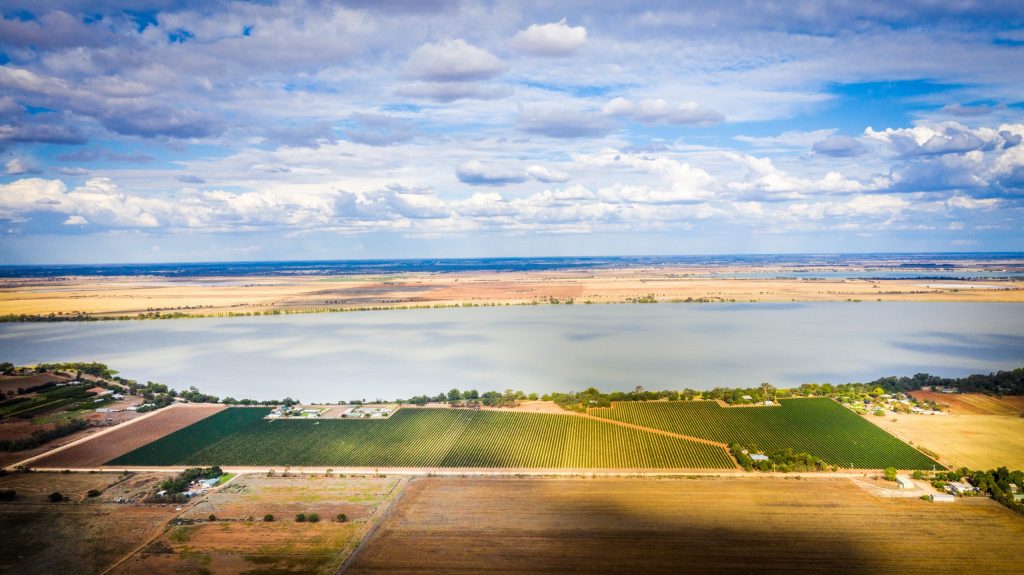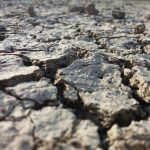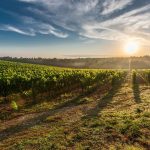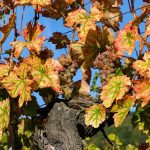Image: Irrigation infrastructure has been ‘pushed to the max’ at Chris Dent’s vineyard on the banks of Kangaroo Lake, south of Swan Hill in Victoria. Credit: Admedia
The impact of extended dry conditions on irrigation and vine management
Hotter and drier seasonal conditions have been a growing concern for Australian winegrape producers. Ongoing severe drought and water scarcity have had a considerable impact on a number of regions, especially in inland parts of the country’s eastern states.
This has forced growers to re-evaluate their usage of water and to find alternative management practices.
Journalist Samuel Squire spoke to growers in three states to find out if and how irrigation has proven an effective way to deal with the extended drought.
In warmer inland winegrowing regions of Australia, irrigation is undeniably fundamental to provide a good quality, sustainably yielding and healthy crop in any season. But, with added drought conditions gripping many parts of the country, effectively managing scarce water resources has become a matter of survival for many producers.
In Victoria’s Murray Valley, demand from winegrape growers for water to irrigate their vineyards has continued to rise as the drought continues and seasonal rains fail.

Murray Valley Winegrowers chair Chris Dent says weather conditions are a determining factor when it comes to the volume and frequency of irrigations during a given season.
“2019-20 demanded significantly more water due to the dry conditions, starting with 30% less rain during the winter period, lowering the initial moisture reserves in the soil so irrigations were needed during the winter to top up the shortfall usually provided by rainfall,” he said.
“Spring rainfall was 61% below average, so the frequency and duration of irrigations was much higher during this period than most other years.”
“Spring also saw a large number of windy days in our region which caused the vines to use as much water as some really hot summer days, so again this prompted longer and more frequent irrigations than usual for this time of year,” Dent added.
He said that further challenges for the region’s growers came during summer, when heatwave conditions in December placed additional strain on vineyard irrigation systems.
“The catastrophic heatwave in December […] really pushed our irrigation infrastructure to the max to apply the water that was needed to maintain the crop and to keep the vines as healthy and cool as possible.”
One way Dent says has helped his own vineyard on the banks of Kangaroo Lake, south of Swan Hill, cope with less water has been night irrigation alongside shorter irrigation periods over the hot summer period.
“During heatwaves, I irrigate our entire vineyard every night but I then do another shorter watering after lunch,” he said.
“While it may not be as efficient as a night watering, I think it sends the vine a signal to “keep going” through the stress of the relentless heat before it gets another good watering that next night.
“I’ve been impressed with the results from doing a top-up watering during the day through heat waves,” he added, “we generally strive to irrigate as much as possible through the night to utilise off-peak power rates and reduce evaporation”.
Dent concluded that his main concern regarding vineyard irrigation during a period of drought doesn’t lie in water availability, but rather it lies in irrigation practice and how and when water is used.
“It’s a given that irrigation is a monumental necessity in our region and we know our vines and our soils very well,” he said.
“Obviously low water allocations and high temporary water prices have forced us to make every drop go as far as possible, but that doesn’t mean using less water necessarily.
“The biggest learning – and frustration – has been more around the water market and regulation,” Dent added.
Moving to dry-grown vineyards
Further north, Queensland’s wine regions have been hit especially hard by severe drought conditions, with the local industry reporting a staggering yield loss of more than 95 percent for this year’s vintage.
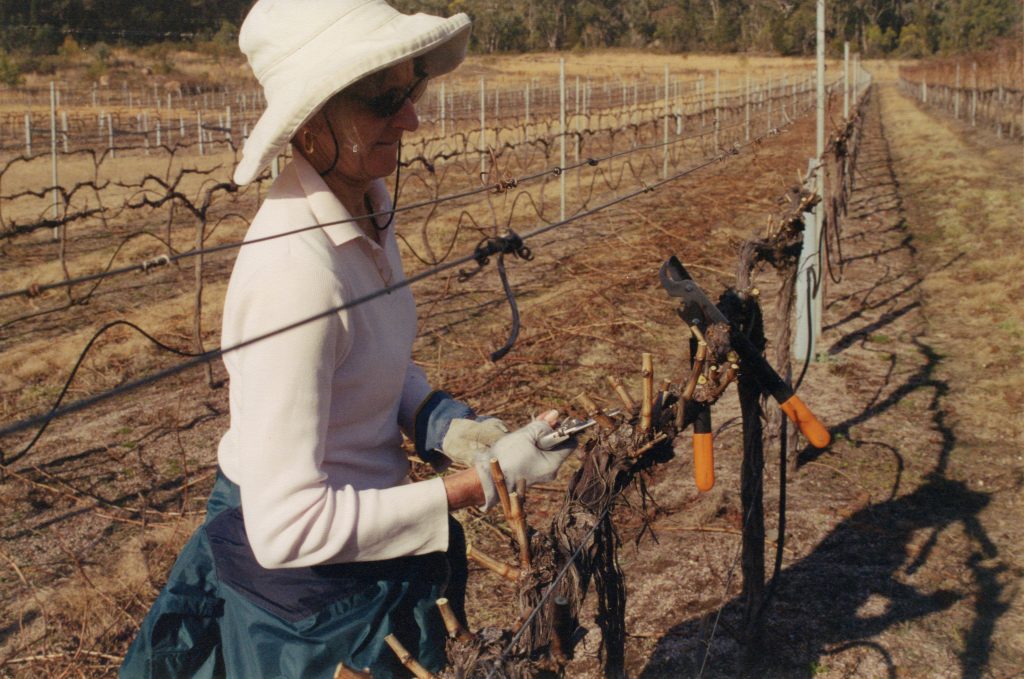
Young vines, in particular, have been badly affected, and producers in the Granite Belt region have had to manage by making the difficult decision to lower overall water usage in an attempt to reduce long-term vine dependency on irrigation.
Suzanne Smith, who describes herself as a cellar hand, vineyard worker and winery all-rounder at Pyramids Road Wines, says the tough decision to limit water to vines was made necessary due to drier conditions over many years.
“There have been previously dry-grown vineyards that have moved to limited irrigation systems, depending on water availability,” she explained.
“The vines [at Pyramids Road] were planted in 1999 and in 2003 [and] we saw a significant dry period when the vines were still young.
“We decided then that the vines would need to survive with less water as these dry periods could be the normal going forward.”
Smith says that this move has worked to the point where the vines have been forced to extend their roots to find ground water supply and now rely less on external irrigation.
“[Since 2003], the vines have been given less water during the growing season so they do not become reliant on water during dry periods,” she said.
“This has forced the roots to find available ground water rather than rely on irrigation water. During the drought, the vines were only given a limited amount of water to keep them alive.”
She added that the timing of water application is also a critical factor during times of drought, and that other, alternative practices have helped to keep the vineyard productive.
“We haven’t had a lot of water to irrigate with, so we’ve had to rely on other ways to keep soil moisture in the ground.
“We have used mulch over the years to keep the vines cool during the summer months and decrease the loss of moisture through evaporation.
“Every other year, we have mulched the vines with various products like mushroom compost, lucerne and sugar cane.
“We also mow the grasses in the mid-row and throw the cut grass under the vine to assist with the cooling of the vine and suppression of weed growth.”
Smith said a limited number of winegrape producers in her region have had access to water for irrigation.
“At one of our recent vineyard walks with grapegrowers, a discussion started with those who had water to give their vines,” she said.
“Watering from budburst to flowering seemed to be most beneficial based on those discussions. Growers that did manage to harvest some fruit this season were those that irrigated early in the season.”
However, that hasn’t been an option at Pyramids Road’s vineyard, nor for many other Queensland growers, as conditions continue to become more extreme.
“Our perspective [on irrigation] changed long before this drought,” revealed Smith, “as over the last 21 years of grapegrowing, the seasons have continued to become drier.
“We started changing our watering regime early on in our vineyard’s life to give the vines less water
“However, this drought has been more severe than the other dry periods we have experienced.”
Meanwhile across the border, winegrowers in the New England region, in north-west New South Wales, have similarly been affected by harsh, dry growing conditions in recent years.
Mark Kirkby owns and operates Topper’s Mountain Wines, which was devastated by bushfire just as the 2019 harvest was about to get underway.
The vineyard’s entire crop, which included many rare alternative varieties – mostly from the Mediterranean – was lost to the flames.
Following that destruction, Kirkby – who’s also president of the New England Wine Industry Association – set out to replant his vineyard with an eye on how best to manage it moving forward as a drier climate becomes the norm for his region.
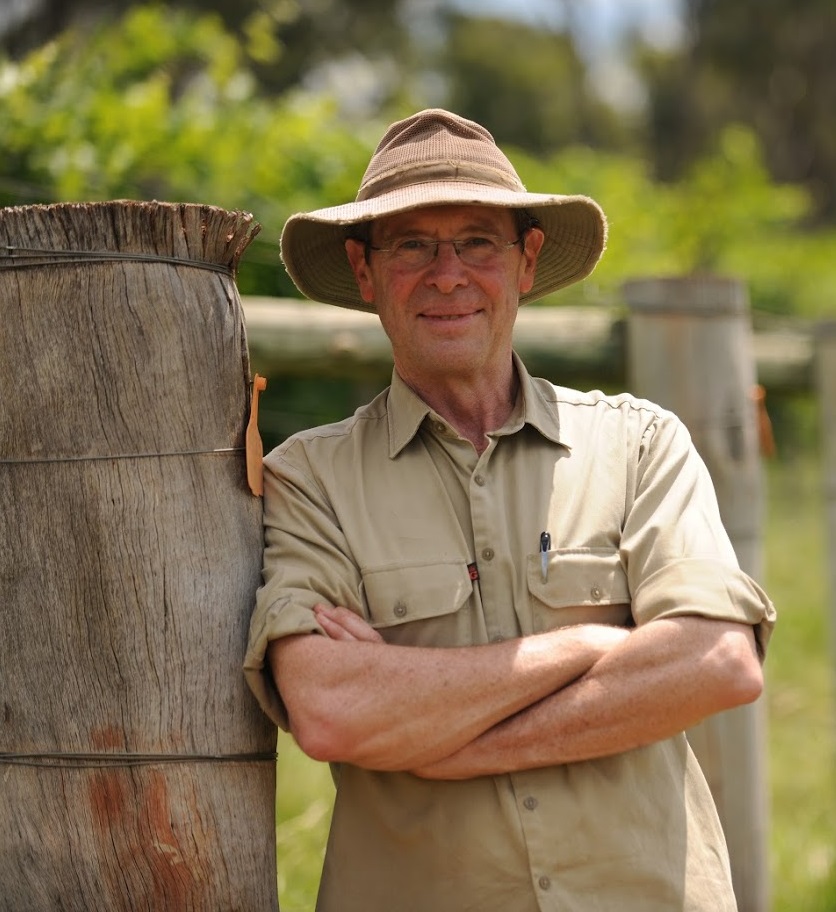
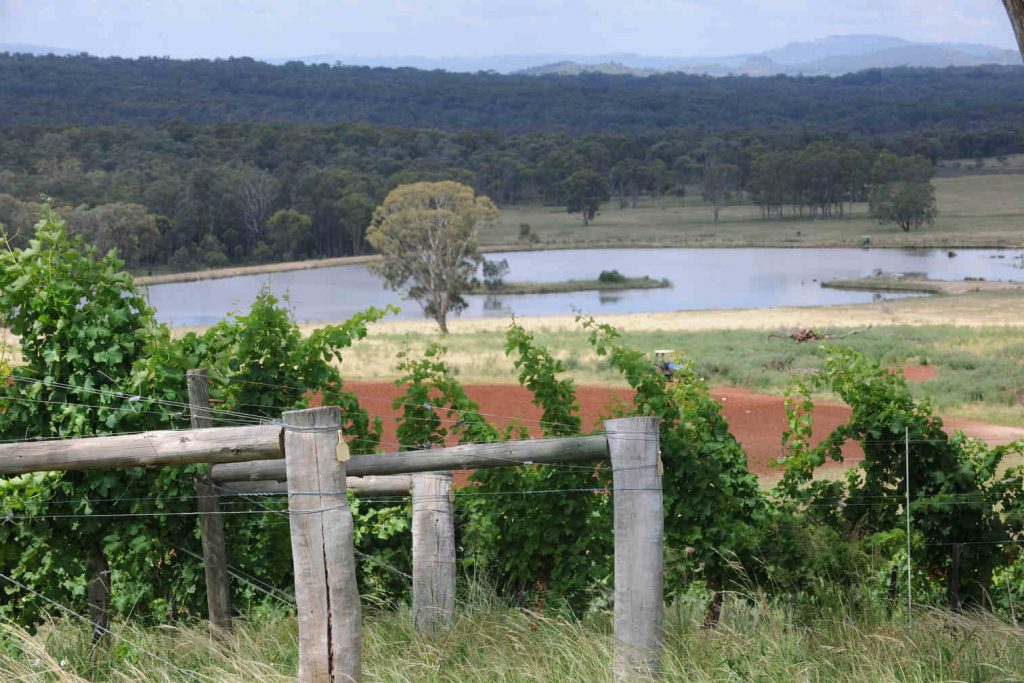
He says that the ongoing drought has placed immense pressure on local growers, with a heavier reliance on irrigation, and with greater frequency and volumes of water utilised in vineyards.
Vines not responding to irrigation
Kirkby said that the start of the 2020 season was so arid in the region that vines were not responding to irrigation attempts.
“Early vintage 2020 was so dry that the vines wouldn’t respond to irrigation, irrespective of how much water we put on,” he explained.
“A number of vineyards in New England didn’t pick fruit in 2020 because they simply didn’t have enough water to irrigate after effectively two years of drought,” Kirkby said.
“In normal seasons – if there is such a thing – we’d normally only have to irrigate The Flat block [at Topper’s Mountain] maybe once or twice in heatwaves, and the Hill of Dreams block three or four times”.
“However, in vintage 2020, we were irrigating almost every week up until the rain began in mid-January.”
Kirby said that local soil types were an issue when combined with the extended dry conditions.
“In discussing this with a number of viticulturists, the only explanation we could come up with is that our krasnozem soils are so free-draining that the irrigation water was going almost straight down into the soil below the dripline.”
Kirkby revealed that the continuing drought has now forced him to “watch the weather like a hawk”, while for the first time ever, Topper’s Mountain’s dam has run dry due to efforts to keep the vines watered.
“Topper’s Mountain has had underground water since it was established in 2000 along with quite a large dam,” he said.
“Vintage 2020 was the first time the dam has been dry, necessitating the pumping out of bore water into the dam to both provide for the vineyard and to leave enough water in the dam for the Murray cod and yellowbelly to survive.”
This article was originally published in the August issue of The Australian & New Zealand Grapegrower & Winemaker. To find out more about our monthly magazine, or to subscribe, click here!
Are you a Daily Wine News subscriber? If not, click here to join our mailing list. It’s free!
